The best electric razor
Braun leads the pack with two of Wirecutter's top picks.

By Dan Koeppel
This post was done in partnership with Wirecutter. When readers choose to buy Wirecutter's independently chosen editorial picks, Wirecutter and Engadget may earn affiliate commission. Read the full guide to electric razors.
During more than four years of testing, a dozen electric razor testers buzzed and clipped a path toward what we hoped would be silken-jawed nirvana—and we found that Braun Series 7 models are the best electric razors for removing facial hair. The 760cc, 790cc, and 7865cc consistently produced close, comfortable shaves. All three models are easy to use and maintain. They're essentially the same shavers—so get whichever one is cheapest.
Braun's Series 7 razors have been around in various forms since 2010, and they have built a reputation for producing close shaves, being durable, and providing convenience and value. The Series 7 has been a perennial pick in many customer reviews and publications, including here at Wirecutter since 2015. It's still our favorite razor, and it's become an even better choice because it's significantly less expensive than it used to be.
The 790cc and the 7865cc provide the same quality shave as the 760cc, with a few extra but unimportant features. Here are the differences: The 790cc has five shaving modes, instead of the three the 760cc offers. Most owners won't even find themselves aware of the two extra modes, and in our tests we didn't notice a difference between modes. The 7865cc, which also has five modes, is marketed as a wet and dry razor—Braun authorizes you to use it in the shower—but since the 760cc and the 790cc are also waterproof, you can probably shower with them, too. That said, we don't recommend shaving with an electric razor in the shower, since electric shavers work better on a dry face. All of the Series 7 models are now similar in price; if you can't find the 760cc, go with the 790cc or the 7865cc (or whichever model is the least expensive—prices can vary widely).
Braun claims the Series 9 can tackle three days' worth of heavy beard growth. (We've generally considered two days of typical growth—if you look like you really need a shave, you're probably at that point—to be as much as a typical electric shaver can handle well.) We found that this razor was as good as its marketing, with an important asterisk: The Series 9 set a standard for performance and speed that most of our testers agreed exceeded that of every other shaver we tried. But most people who shave their facial hair—whether they're five-o'clock-shadow-by-noon types or light-and-wispy-bearded—don't need the performance boost. Nearly everyone can get a shave that's just as velvety from the Series 7.
Although we believe the Series 7 will please just about anyone who tries it, the Remington F5-5800 is a surprisingly competent alternative. It provides credible stubble-leveling results at a genuinely affordable price. None of our testers thought it was on the level of a Braun—but then again, it's less than a quarter of the price. But unlike the Braun Series 7 and Series 9, this model does not come with a cleaning system.
Based on our research and testing, we believe a foil shaver produces a better shave for most facial hair. But if you prefer a rotary style, consider Philips Norelco's Shaver 9300 (or another model in the brand's 9000 line). Rotary shavers operate differently than foil shavers, using floating heads that grasp and remove hair, which some people find more comfortable.
Why you should trust us
I'm a razor enthusiast, and I love playing with both manual and electric razors. In the four years that I've been writing about razors for Wirecutter, I've personally tested more than 30 models: the full lines from Braun, Panasonic, and Philips Norelco, as well as one-off brands and used shavers (don't do it!) that I found in the deepest, darkest corners of eBay.
Over four years, I've monitored other reviews of electric razors—especially the extensive advice in Tyler's Electric Shaver Guide—and comments on shaving forums such as Badger & Blade, Reddit's r/shaving, and multiple threads on Ask MetaFilter. I also visited one of the last surviving brick-and-mortar electric shaver shops in North America. Canada's Centre du Rasoir chain still has over 30 outlets, mostly in Quebec province. In spring 2019, I stopped by the Montreal branch and viewed every model of Braun and Philips shaver on offer, side by side.
Who this is for
Two of the reasons you may prefer using an electric razor on your face instead of a manual one are convenience (being able to shave anytime, anywhere without water) and safety (no risk of nicks).
If you find manual shaving too rough on your skin, try electric. Although neither method is specifically more gentle, people who have problems with one kind of shaving or razor often do better when they switch. Those with especially coarse or curly facial hair can be particularly predisposed to ingrown hairs and razor bumps, and the less-close shave of an electric razor, or shaver, can help.
Though most manufacturers insist that their electric devices can smooth your face as well as a traditional blade (and this may be true for some people), the physical mechanics—how electric shavers actually remove your stubble—create a closeness limit that some owners will certainly notice. If a close shave is your top priority, you may find that an electric razor simply cannot compare to a manual one.
Electric shavers vs. manual razors
Manual razors—whether an old-fashioned, single-blade straight edge or an ain't-this-ridiculous seven-blade modern non-marvel—all operate under a simple principle: A sharp blade glides across your face and slices your whiskers close to the skin. Multiple-blade systems add a theoretical second action (razor makers call this "hysteresis") in which the first blade pulls your whisker outward and subsequent blades—a second, third, fourth, onward to infinity—cut that pulled follicle even closer. But no matter how many blades your manual razor boasts, the fundamental mechanics—a knife-like slicing—remain the same.
Electric shavers work on a totally different principle. Foil-based systems use one or more cutting blocks mounted beneath the thin metal head. The foil's perforations guide the whiskers into the block, where a pair of opposing blades slice them off. The action is more like what you'd get from a pair of scissors than from a knife. Rotary shavers use similar perforated surfaces to guide whiskers toward their cutters, but instead of snipping, hundreds of tiny blades slice hairs with a circular motion. Imagine the horizontal spinning blade on a power lawn mower—but with teeth—and you'll get the idea.
The foils and circular heads of electric razors keep your skin and the cutting mechanism from achieving contact, making it impossible for them to "shave as close as a blade." No matter how thin those barriers are, you'll never get the cutting part of an electric shaver as close to your face as a standard razor blade.
One way shaver makers have tried to improve closeness, to compensate for the barrier layer between shaver and user, is by employing mechanisms that lift, cut, and guide facial hair into the cutter. In addition to including multiple heads, foil shaver makers add jagged guide blocks that are designed to capture longer, tougher hairs; the variable patterns are intended to act as whisker-trapping labyrinths. Rotary shaver makers use beard lifters that are built into the dozens of tiny, spinning blades; they're generally scythe-shaped, so hairs are (in theory) scooped up and pulled taut from beneath the skin line, at which point they can be cleanly cut. Both rotary and foil manufacturers add pulses and sonic vibrations to their higher-end models. These are designed to get your whiskers standing a little straighter, for better contact with the shaver's cutters. (In practice, we've found that shavers with higher pulse rates do tend to smooth the face a little more efficiently, and they reduce the amount of pressure needed to get a clean shave.)
How we picked and tested
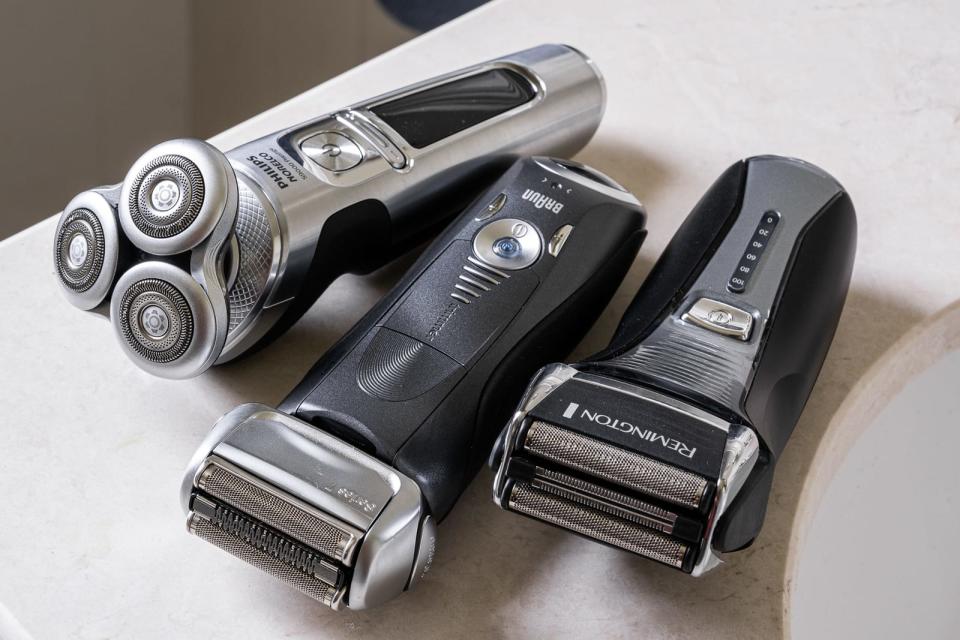
One thing that makes choosing an electric shaver confusing: Nearly all manufacturers offer their razors in accessory- and feature-laden (or not) "Series" sales schemes. Some come with cleaning systems; some don't. Some can be used in the shower with shaving cream; some can't. Some have digital readouts showing how much battery is left in the shaver or whether it needs to be cleaned; others offer simpler LED displays.
Here's the thing: The razors all provide the same shave. Any Braun Series 7, regardless of accessories and features, will shave your face just as closely as any other Series 7. The same goes for anything in Panasonic's various series designations, and for Philips Norelco and Remington models. But adding or subtracting a feature or two can shift the price of a shaver by as much as $100. For that kind of money, it's important to decide what's worth it—and what isn't.
We examined customer reviews at Amazon and other retailers to find the top-rated, best-selling electric razors. (This was more difficult than it sounds, since the multiple layers of same-shaver-with-different-accessories model-number chaos means multiple listings for what is essentially the same razor.) While we looked at a variety of features, we decided early on that our judgement of the winning shaver would be based almost exclusively on closeness of shave. That's because ultimately it's the most important thing—and because nearly all of the shaver makers offer versions of their various devices with and without bells and whistles.
Beyond closeness of shave, we considered:
Rinsability: The ease of rinsing a shaver in the sink—especially when traveling—is important. A little warm water and a gentle brushing will clean your razor as well as a standard cleaning system.
Cleaning systems: Though you can clean almost any shaver manually, a cleaning and charging dock automates the process. It's especially convenient to be able to shave and then just pop your razor into a docking station and have it charged and ready to go the next morning. Note, though, that automatic cleaners are generally loud (some roar, others just whirr) and bulky, requiring counter space, which may be at a premium in a bathroom or an apartment. Although you can usually purchase a cleaning system separately, if you'd like this feature, it's almost always more economical to buy a shaver that comes with one.
Ergonomics: A shaver should be comfortable to hold and should easily maneuver around the contours of your face.
Display: We looked for models that offer, at a minimum, a lighted battery indicator. We found more elaborate digital displays nice but not necessary.
Other extras: The often-overlooked carrying case is a big plus. The heads and foils on electric shavers are delicate and need to be protected. Most shavers come with some kind of carrying or protective device. Lower-end shavers tend to come with plastic head guards that snap on for transport. They work, but we managed to lose almost every one of them during our months of testing.
We enlisted a panel of 12 to test a dozen electric razors. Our physically and ethnically diverse panel included people with heavy beards who shaved daily, people with light beards who shaved as little as once or twice a week, and people who had tight, inward-curling facial hair, which frequently leads to razor bumps.
We asked testers to evaluate each razor for closeness of shave, speed, and irritation. First, testers used the razors at whatever their standard "I need a shave" interval was. We then asked for a double-growth test—skipping a shave—and, as a go-for-broke scenario, a triple-growth test.
We had the testers keep top-performing razors for extended periods, to allow for break-in time. We asked testers to shave one side of their face with one razor and the other side with another so they could perform direct closeness comparisons (compensating, of course, for problem areas; many people find that one side or portion of their face is tougher to shave than another).
In addition, we weighed each model and measured the noise (decibel level) of each razor during operation. We didn't test battery life, specifically; all of the models we picked were capable of running for about an hour on a full charge.
Our pick: Braun Series 7

For a consistently close shave, plus the convenience of an included automatic cleaning system at a reasonable price, we recommend the Braun Series 7. The 760cc, 790cc, and 7865cc are effectively all the same. Prices and availability can vary, however.
While it didn't earn superlative marks on all the criteria our testers evaluated—some testers found the Braun to be overly noisy—it was the only shaver that everyone agreed worked well, shaving closely without creating irritation. Overall, we've found that Series 7 razors offer a just-right combination of upgrades (over Braun's lower-end models) and affordability (compared with the newer, Series 9 shavers).
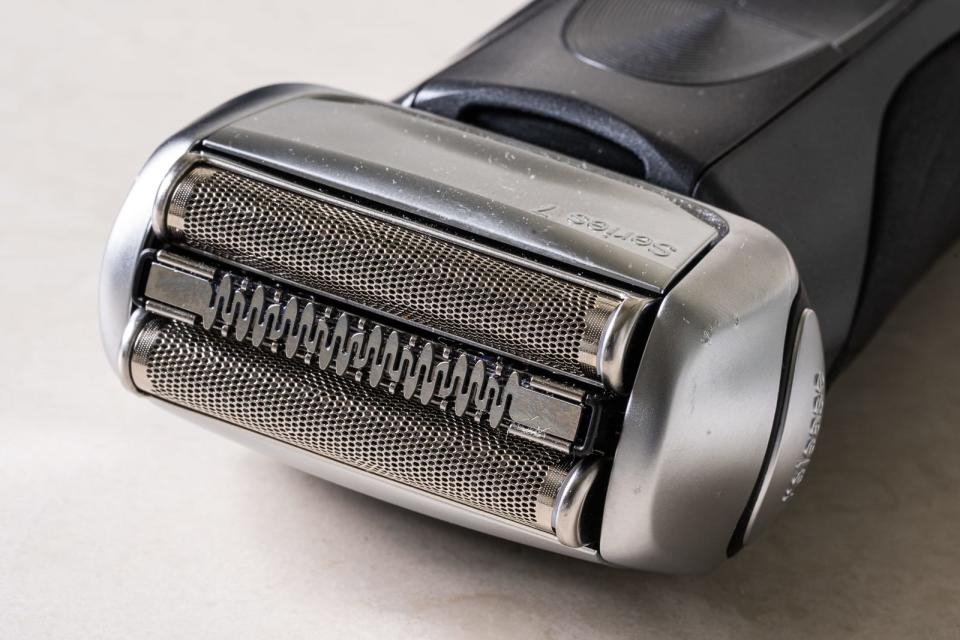
If you look at all four Braun series offerings—the 3, 5, 7, and 9—you'll notice that they use fairly similar designs when it comes to foils. Each is fundamentally a double-foil shaver with a trimmer mechanism located between the foils. In the Series 3, 5, and 7, there's just a single trimmer.
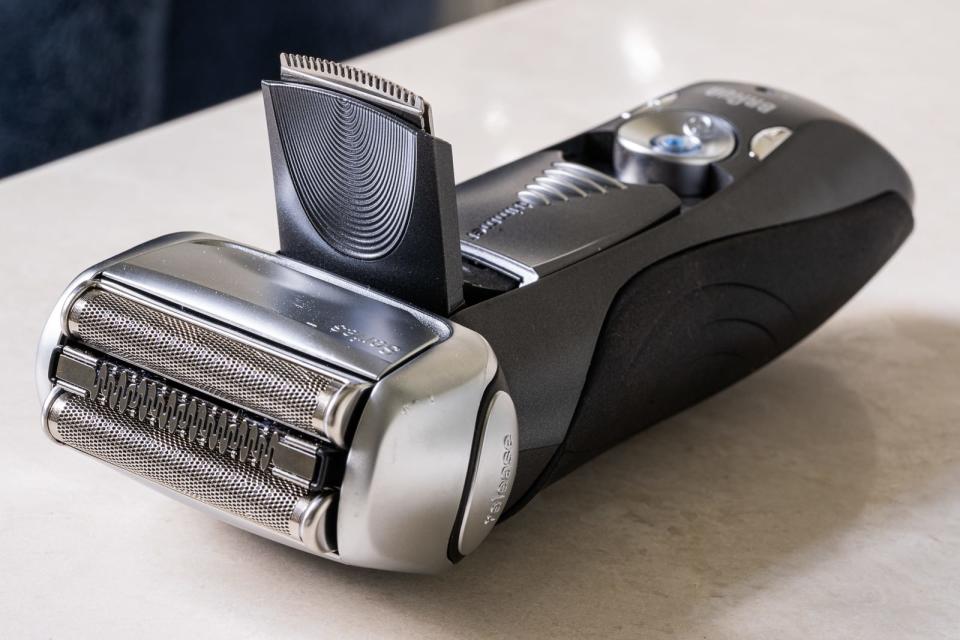
If you observe the razor when you turn it on, you'll see that the trimmer has openings that vibrate when activated; the idea is that the vibration captures the toughest parts of a beard with a high-speed scissoring action. Our testers who preferred the Braun shavers—and that was most of them—reported that they did notice a difference among lines. The Series 3 shavers were the least-liked Braun models.
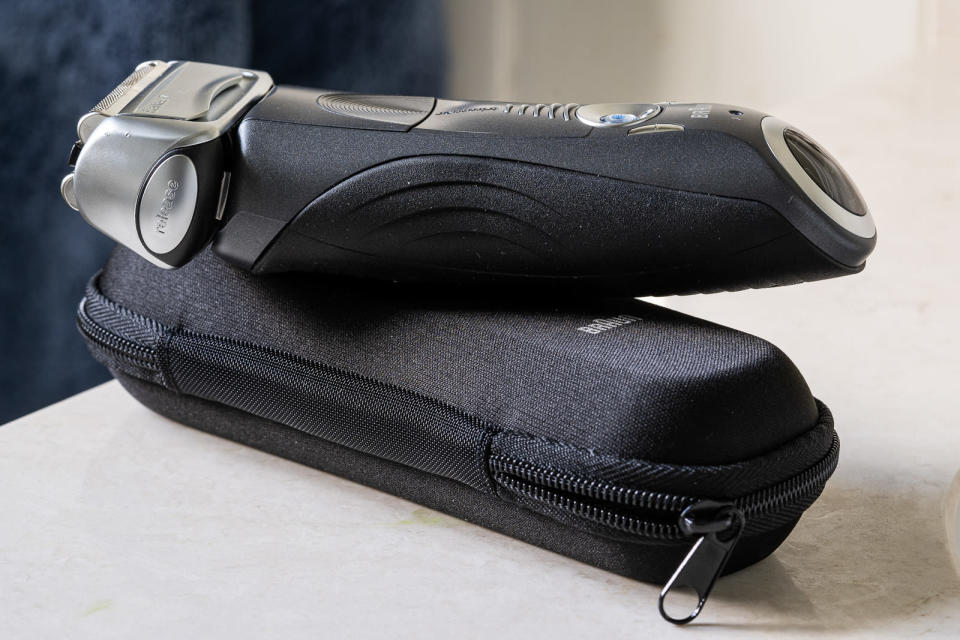
The difference that sets the Series 7 apart from other Braun models, including the cheaper Series 3 and 5, is mostly internal, like the different sounds the shavers make while in operation. The Series 7's higher-pitched buzz is a result of the shaver's Pulsonic technology; faster vibrations are designed to lift hair more completely (in practice, we found this to be true, or at least it seemed to be). The Series 5, by comparison, has a throatier, more mechanical sound.
Braun recently began offering a Series 8 shaver as an exclusive at Costco, and it sells for less than a Series 7 usually does. We examined one, and we determined that the Series 8 is actually a rebadged Series 5 with a larger battery.
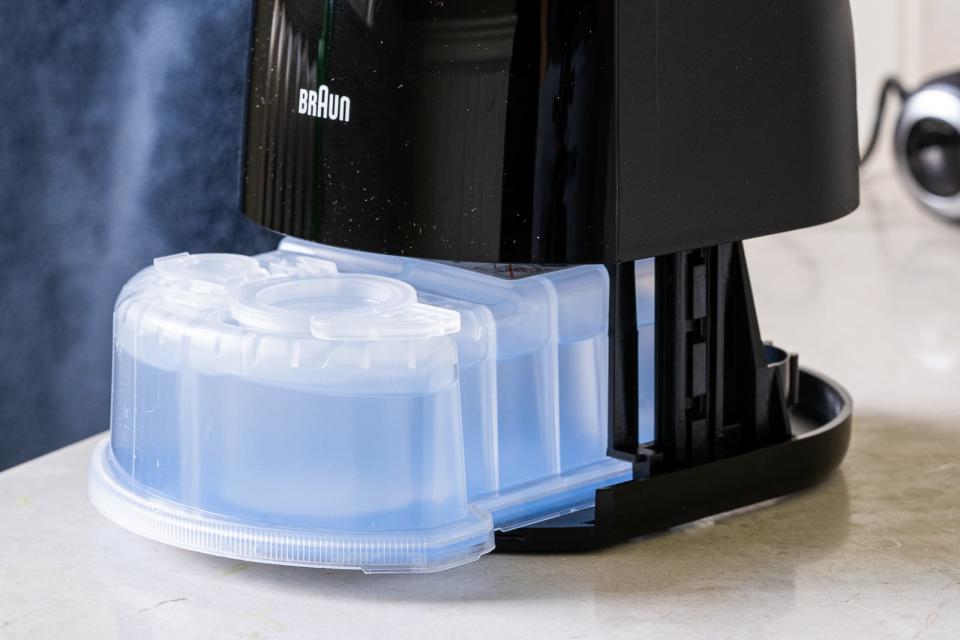

The Braun Series 7's cleaning and charging system is typical of those available for our other picks. A large docking station holds the shaver, head down. Inserting the shaver starts a process that includes charging and evaluating how much cleaning the shaver needs. Once that's determined, the docking unit immerses the shaver in cleaning fluid—this comes in consumable cartridges, and each lasts about three months—and then cleans the shaver and conditions the blades (if you choose to clean manually, you'll have to condition the blades yourself with a purpose-built solution, like Remington's Shaver Saver).
You'll need to replace the foil on your shaver more or less annually, depending on use. Series 7 foils generally run about $30.
All Braun shavers include a two-year warranty, which covers everything but the foil and cutting block.
Upgrade pick: Braun Series 9
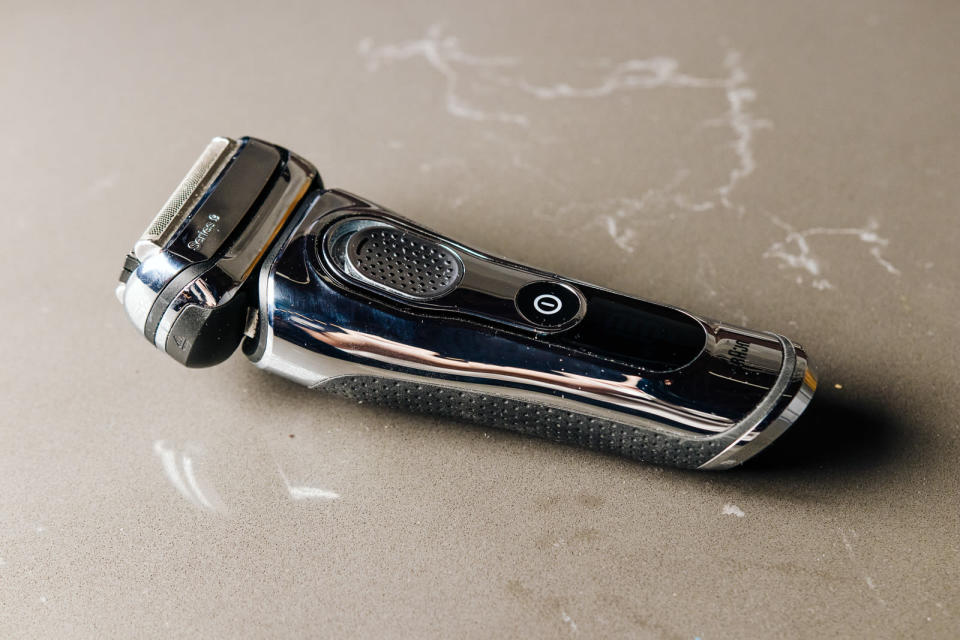
While the Series 7 is powerful enough for most shaving situations, Braun's Series 9 is the top-performing shaver we've tried that we find worth the additional expense—at least for certain situations. If you have particularly curly or coarse hair, or wish to shave less frequently but achieve the same level of closeness, this may be the shaver for you.
At first glance, the biggest difference between the Series 9 and the Series 7 is size. Though the razors weigh the same—about 7.6 ounces each—the Series 9 is longer, has more girth, and is more top-heavy, thanks to its quadruple-headed shaving mechanism. That four-way head sticks to the company's traditional two-foil design but adds a pair of cutting mechanisms—a "direct & cut" trimmer and a "hyper-lift & cut" trimmer—that the company claims better snag wiry, unruly whiskers.
Most of our testers agreed that the Series 9 is an amazing shaver. When I tried it on my three-day beard, I found that it worked better than any electric shaver I'd ever used—though it paled in comparison to a standard blade when confronted with my iron curtain of a half-week's whiskers.
That extra power and performance come at a dollar and design cost. Series 9 razors are notably bulkier than Series 7 razors, and some testers found the Series 9 razors tough to maneuver in the tight spots (like the equally ginormous Panasonic Arc5, which the Braun somewhat mimics).
Braun's Series 9 clean-and-charge base uses the same cartridges as the Series 7 (and all other Braun shavers) and is functionally identical. Replacement cartridges last about three months and cost about $25 for a four-pack. Replacement foils are considerably more expensive for the Series 9; they currently run about $50, compared with about $30 for the Series 7.
Budget pick: Remington F5-5800
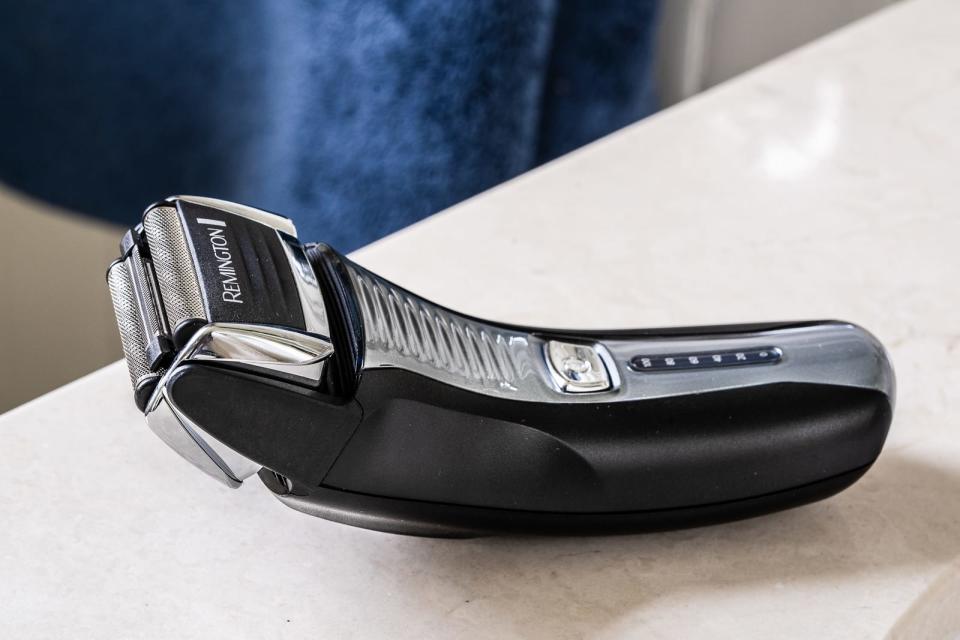
Among electric razors under $50, the Remington F5-5800 outperformed lower-end Braun and Panasonic models in our testing. Each of our testers said it gave a sufficiently close shave.
The F5-5800 has the look of a Braun clone and uses a proven dual-foil system with a center lift-and-cut trimmer mated to a pivoting head. Although there's no cleaning system available, you can easily rinse the shaver under running water.
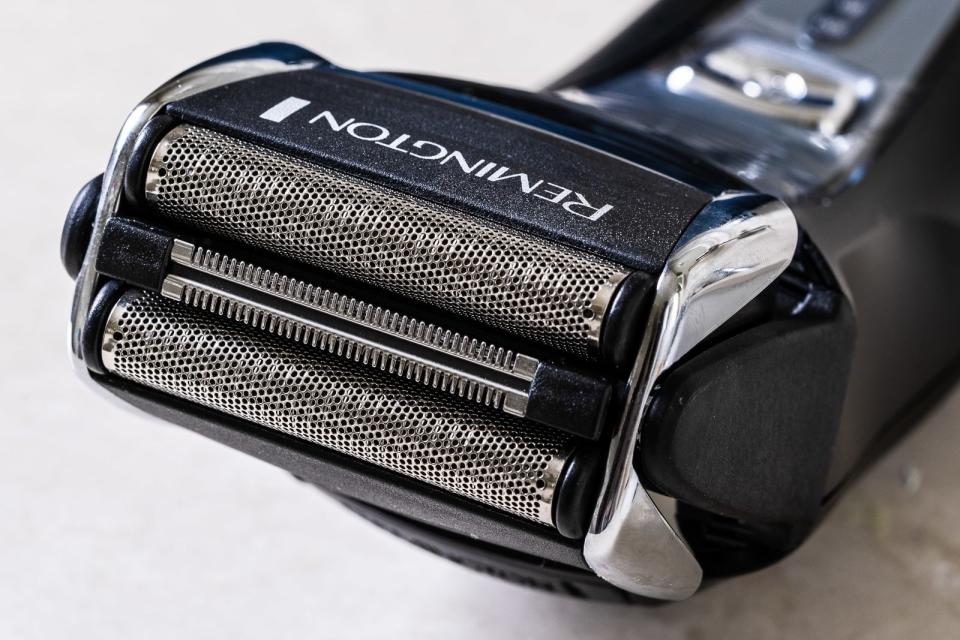
The battery life is about 60 minutes, a bit less than the Braun's, but it's more than enough for most owners, even when you're traveling. Remington's replacement foils are half the price of Braun's and Panasonic's (though you may have to replace them more often—not because they're any less durable, but because the Remington comes only with a cheap plastic head protector that's easily lost).
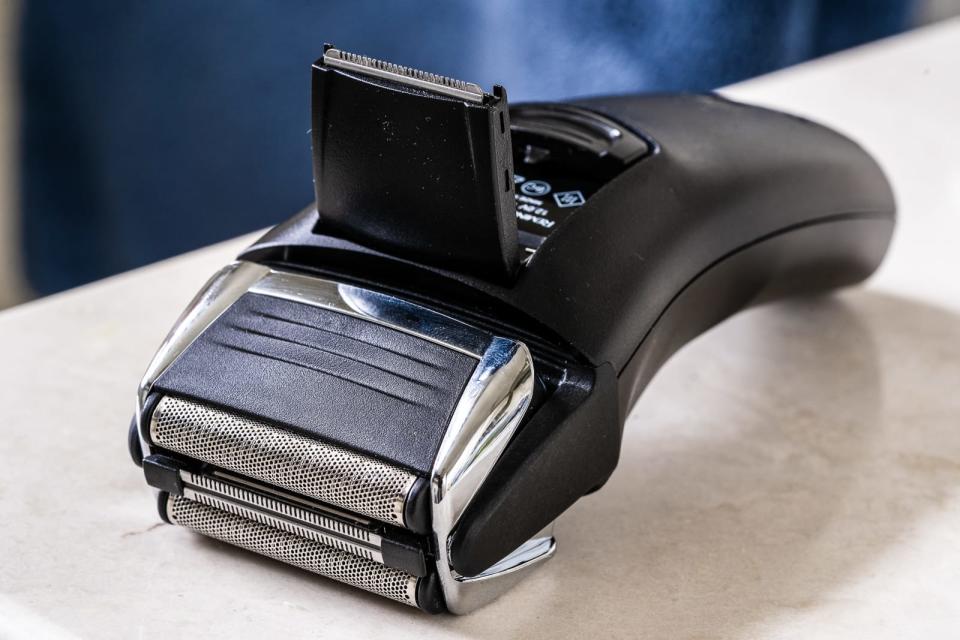
The Remington offers generally good performance, but you'll likely find the shaving experience itself to be buzzier and potentially more irritating if you don't maintain a very light touch.
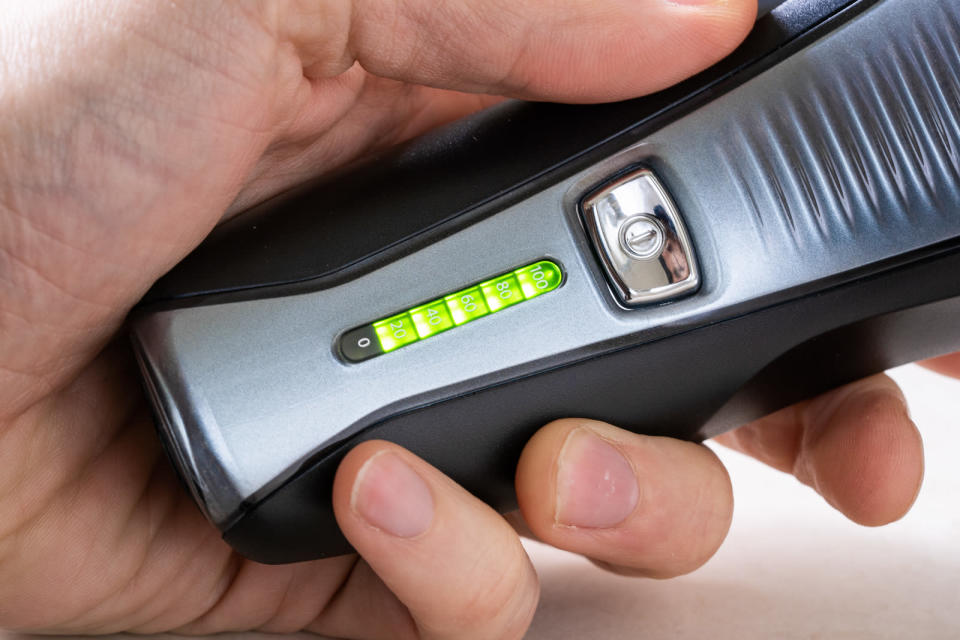
As with the more expensive Braun models, this Remington comes with a two-year warranty. Remington recommends annual replacement of the shaver's cutting block and foil, which are sold as a combo pack for about $20.
Also great: Philips Norelco Shaver 9300
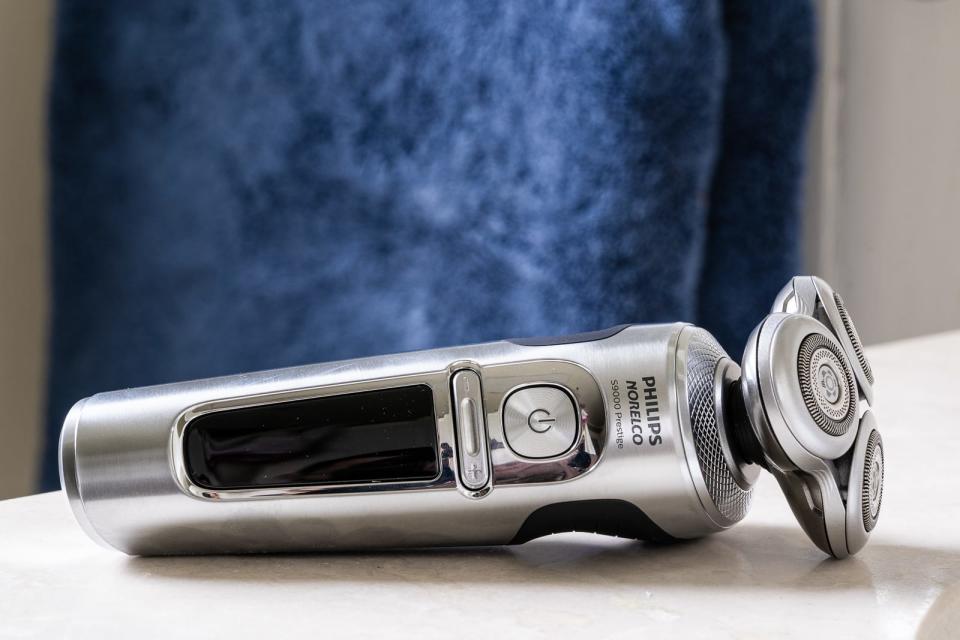
For most people, foil-style electric razors typically provide a closer shave. But if you prefer a rotary-style shaver, we recommend the Philips Norelco Shaver 9300, which includes a cleaning system.
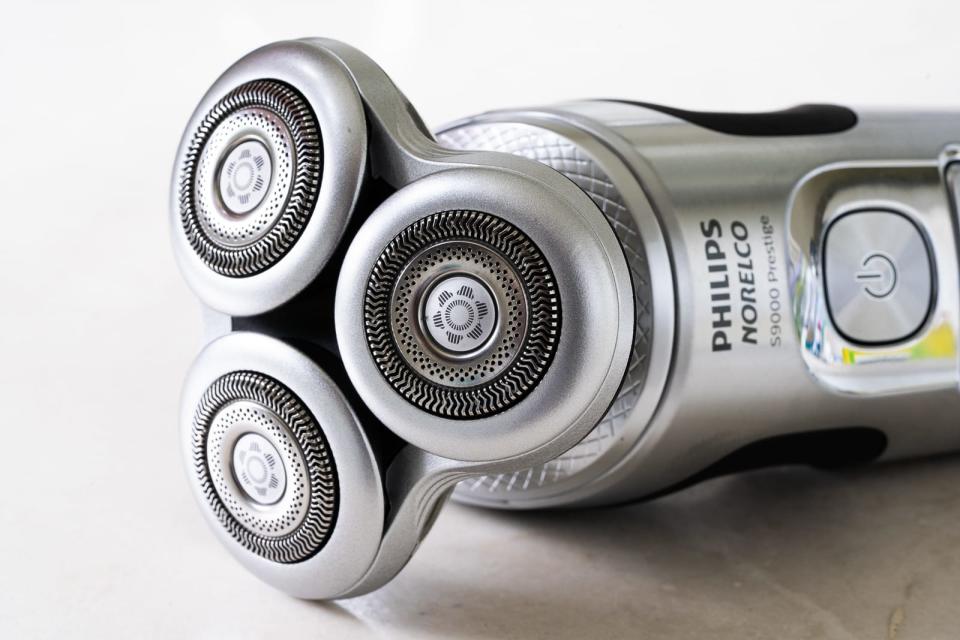
Like the Braun models, these shavers are marketed in series. If you can't find the 9300, get whichever 9000 series model is cheapest. In 2019, we tested the latest model, the S9000 Prestige (pictured), which includes a digital battery meter—a nonessential upgrade—but, unlike the 9300, doesn't include a cleaning system. It shaves the same as the 9300 does.
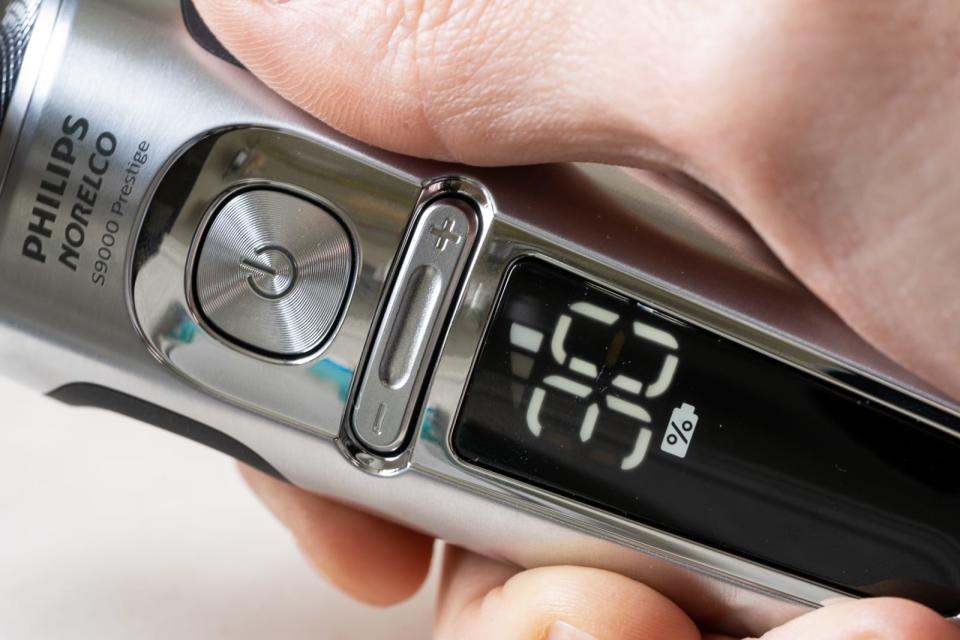
The 9300 can be unwieldy. The trimmer is a separate attachment that requires removing the floating head. And because the triple-headed shaver isn't as compact as a foil shaver, it needs a larger case, which will take up more space in your luggage.
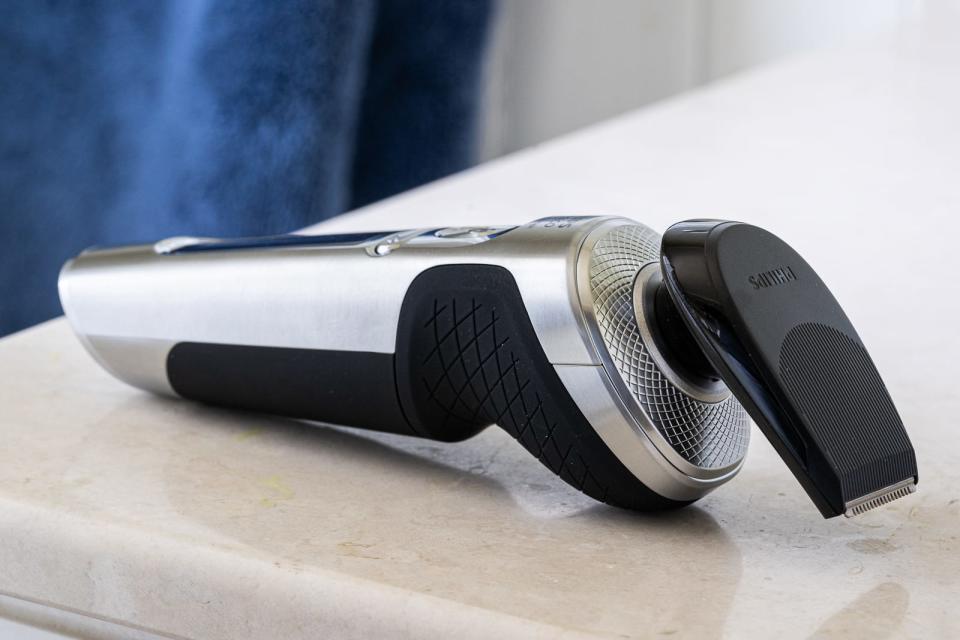
Philips Norelco doesn't integrate cleaning systems across its model line like Braun does, and though we think the brand's cleaning bases work well, they're a little unwieldy to use compared with Braun's, and cleaning cartridge replacements are harder to come by.
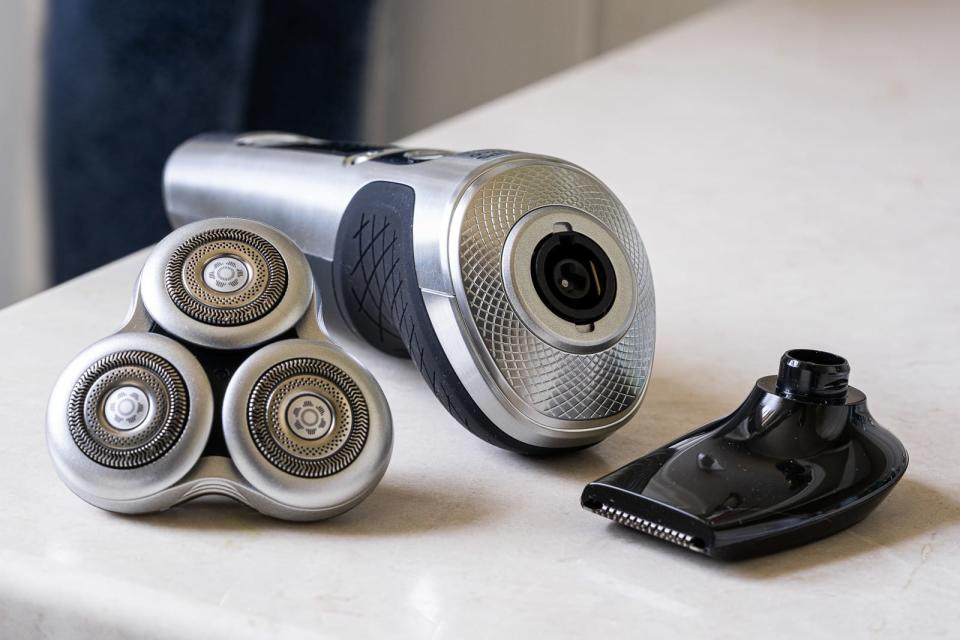
Because of their shape, Philips Norelco razors need to be held in the cleaning base by a kind of stalk-like support, which means an extra step of inserting the razor. You'll have to decide whether the convenience is worth it; maintaining your shaver manually with the included cleaning brush is certainly easy enough.
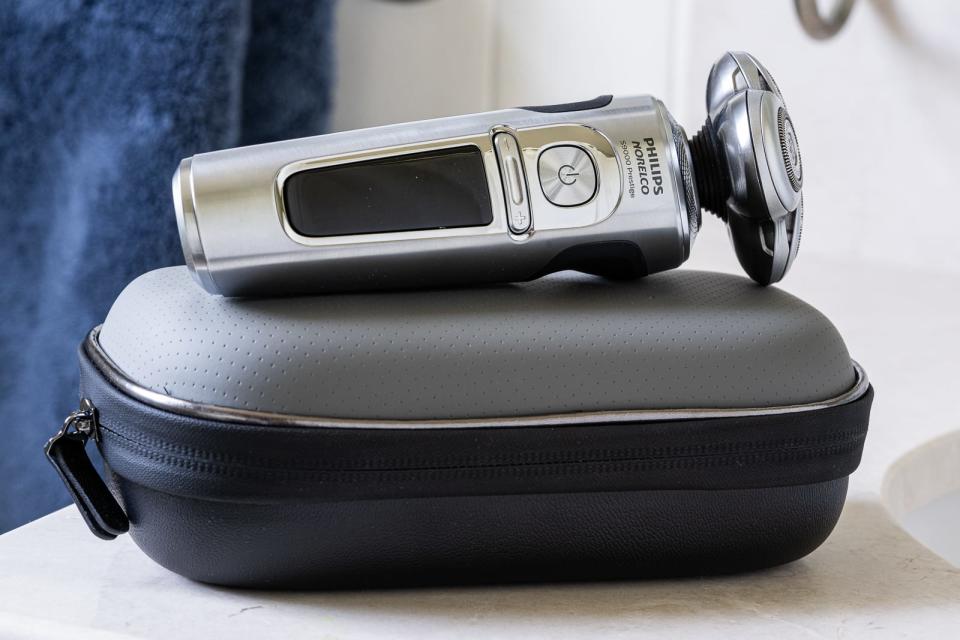
The 9300 requires annual cutter replacement. The shaver includes an indicator to let you know when the time comes, and the cutters cost about $50.
All Philips Norelco shavers come with a two-year warranty.
Use, care, and maintenance
An electric razor needs break-in time—not for the razor, but for your face. If you're switching from a manual to an electric, or even from one electric style to another, you'll generally need to give your skin two weeks to adjust to the new tool. We couldn't figure out exactly why this break-in period is needed. Is it your face? Your shaving style? The razor itself? Different sources give different answers, ranging from new-user error to the need to "train" skin as it adjusts from healing the scrapes caused by a manual razor to the pulling and shearing mechanisms of electrics.
We did a literature search and found no academic research on the topic, though in our experience, the break-in period is real. Your first electric shaves will be patchy and probably painful, and you shouldn't touch things up with a manual razor (which defeats the purpose of the break-in period). All major shaver makers offer a 30- to 60-day money-back guarantee, and we recommend that you give your new shaver time to reach peak performance—but don't be shy about requesting that refund if it doesn't.
To get the smoothest, most comfortable electric shave, no matter which shaver you choose, you'll need to remember that electrics can't easily get as close as a blade. Most electric shaver makers offer advice on how to get the optimal shave. Unfortunately, that advice sometimes conflicts. Braun, for example, suggests shaving first thing in the morning ("We recommend that you shave before you wash, since the skin tends to be slightly swollen after washing."). Philips says to wash but not shower ("...otherwise your skin will be hot, puffy..."). Our testers used different techniques. I've dabbled with electric razors most of my adult life, and my technique is based mostly on saving time. Since I have two kids, I'm always in a rush first thing in the morning; when I'm using a manual razor, I shave in the shower. But with an electric shaver, I wait to shave during a calmer moment midmorning.
No matter when you shave, be sure to follow some basic-technique tips. Men's Health UK offers a fairly extensive tutorial, but the takeaway is: Go lightly. Don't press those cutting blades into your skin. Instead, gently pull the skin taut with one hand and let the razor glide over your face in slow, steady strokes; experiment with circular motions and straight strokes, and going with or against the grain (you're looking for the perfect balance of closeness and post-shave comfort). All of the razors we recommend have pivoting heads, so maintaining a proper angle is easy, but if you're using a shaver with a fixed head (like a Wahl), make sure to hold the head at a right angle to your skin. Nearly every shaver manufacturer—in a tacit admission that these devices don't really shave as close as a blade—recommends that you snag your longest, toughest facial hairs first, using the shaver's built-in trimmer. Several of our testers said they used a manual razor to get those hairs at the end of the shave, which to us felt kind of like a "what's the point?" proposition.
One question we've been asked a lot is whether to use a pre-shave. The best known of these is Williams Lectric Shave, an alcohol-based solution that helps "the shaver glide with less irritation." It used to claim—see this advertisement from a 1982 issue of Field & Stream—that it made a "beard stand up." How much this actually happens isn't easy to establish, and I was the only tester who actually uses and likes a pre-shave. The magic ingredient in most pre-shaves is isopropyl myristate, a synthetic oil created by compounding alcohol and a fatty acid. Combined, the two provide lubrication (the substance is also a key ingredient in Liquid Wrench) without a greasy feeling, so claims that they help an electric razor to glide are probably credible.
Although I don't use Lectric Shave—it smells too much like my Uncle Larry's bathroom—my preferred pre-shave, Kyoku for Men Electric Pre-Shave Optimizer, contains that key ingredient, which I find does make my skin feel smoother and more taut for shaving. Other pre-shaves include powders, which are effective but messy, according to Amazon customer reviews, and thicker creams (like in Mennen's Afta), which tend to gunk up the shaver, making it tougher to clean.
You can use shavers in the shower, but a dry face is generally recommended to get the smoothest electric shave. We found that using shaving cream made for a foil-clogging, extra-gooey experience. Using shaving cream is likely going to increase the amount of time you spend shaving, if you want to reach the closeness you'd get going dry.
Most shavers are rinsable, and you can easily clean them under water with a quick brush of the foils. Some, like the Braun Series 7 models we recommend, come with cleaning stations. Generally, replacement cleaning cartridges last about three months and cost $5 each, if you buy them in four-packs. You should also follow the manufacturer's instructions for replacing foils and cutting blocks. Braun recommends replacement every 18 months (the block and foil come as a single unit, running about $30 for the Series 7 and $50 for the Series 9); Philips Norelco and Remington recommend annual replacement.
One warning for on-the-go shavers: The foil heads found on most electric units are fragile, and if you dent or bend one, you'll need to replace it. Most shavers come with some kind of case or shaving-head protector. It's a good idea to use it.
The competition
Like Braun, Panasonic offers razors in series with and without cleaning units. The company's top-of-the-line series, the Panasonic Arc5, includes a total of five blades—a quartet of foils and a single oscillating lift-and-cut center trimmer. Like the Braun Series 9, the Panasonic Arc5 is a bulky unit, and some of our testers found the oversize heads difficult to maneuver, especially around the mustache area. And overall, we found that despite the extra shaving heads each of them comes with, neither the Arc5 nor the Panasonic Arc4—basically the same shaver, but with one less foil—shaved as well as the comparable Brauns.
Another negative was the glossy black finish found on most Panasonics. It was a "fingerprint magnet," one tester reported, adding that "it looked undesirably dirty after use." Our testers found, however, that manually cleaning the Panasonic models—without a cleaning system—was much easier than manually cleaning the Braun models. The foil and heads of the Panasonic units pop off with an easy button push, exposing the cutting blocks for quick rinsing.
We tried Philips Norelco's lower-end rotary models but found that the brand's 9000 series performed better, and it was so closely priced that it was a better buy for most people. In our experience, the 3000 and 4000 series razors didn't shave closely enough to be worth their bargain prices. However, one member of our test panel has been using a 4000 series for years, and they still love it, even after trying much more expensive models.
If the 9300 is unavailable or you're shopping for an even-more-budget rotary, we recommend you opt for any Philips Norelco model rather than one of the many inexpensive—and face-mangling—three- or four-headed knockoffs popular on Amazon and eBay.
We initially wanted to look at Wahl's legendary 5 Star shaver; the maroon-colored model is beloved by barbers, who have nicknamed it "The Brick." But since it's generally sold via pro barber-supply sources, we opted for a close cousin, the company's Custom Shave. The Custom Shave is about as generic-looking an electric shaver as you can find—a tapered hunk of black plastic, with a non-floating head and an on/off switch. It comes with a trio of interchangeable foils: one for standard closeness, one for sensitive skin, and another for "ultra closeness." The foils are visibly different—smaller holes mean a less-aggressive shave—and Wahl spokesperson Steven Yde recommends that owners "never begin with the ultra head." Yde warns: "It will eat you alive." A couple of our testers really liked the basic look and feel of the Wahl and found that the shaver cut powerfully and smoothly. That said, you can't clean the Wahls under water (you use a brush), and they don't have a terribly good reputation for longevity, according to Amazon customer reviewers.
We've also tried a few oddball electric razors. These include Hitachi's well-regarded but not-available-in-the-US S-Blade RM160, a shaver that features a unique cutting technology that's a sort of foil-rotary hybrid: There's a rotating blade underneath a foil head; the cutter spins like an old-fashioned push lawn mower, rather than lying flat, as the car-wax-buffer-like disc on Philips rotaries do. We also tested the sub-$10 Aokai T01 and the sub-$10 Kemei Classical Multifunction Model 5600. These cheapies showed us that technology and craftsmanship do matter and that there's a limit to how low in price a shaver should go. Both of these models dip significantly beneath that waterline, though the Kemei gets a few goofball style points because it 1) has a fake, stitched-leather finish; 2) looks like an oversize cigarette lighter; and 3) has a built-in mirror (we especially loved the built-in mirror—what a great idea, we thought, except, of course, that you can't actually look into it while you're shaving).
Finally, simply for style—they're gorgeous—we bought a couple of vintage shavers on eBay: an original Schick from the 1930s, as well as Ronson and Remington models from the 1960s. As lovely as these vintage shavers are, electric shavers require regular maintenance, so buying a used one is generally a dead end because replacement parts simply aren't available.
This guide may have been updated by Wirecutter. To see the current recommendation, please go here.
When readers choose to buy Wirecutter's independently chosen editorial picks, Wirecutter and Engadget may earn affiliate commissions.
